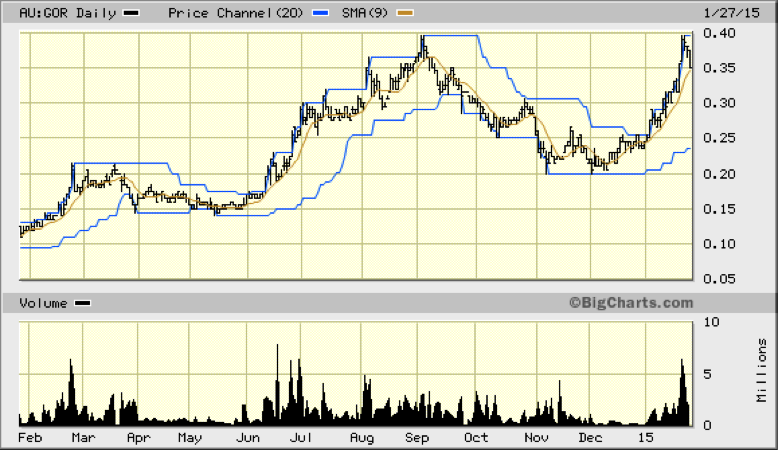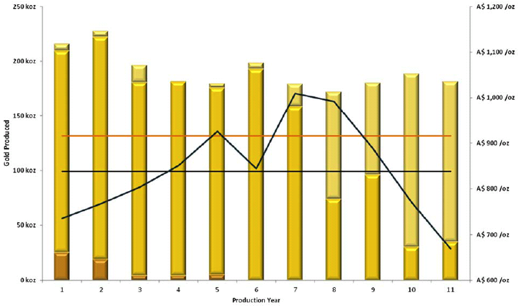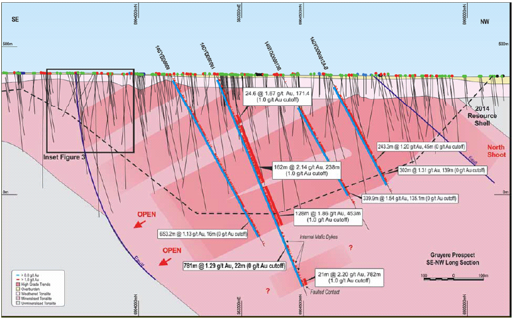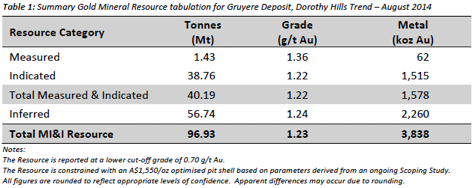Gold Road (ASX: GOR, Share Price: $0.35, Market Cap: $196m) is one of our long-standing emerging gold exposures that we introduced to our Portfolio during December 2010. Gold Road has maintained aggressive and focused exploration and appraisal activity with respect to its vast Yamarna Belt gold project – an underexplored region encompassing an area of 5,000 sq km area within WA’s Yilgarn Craton.
The company has announced the completion of the Scoping Study for its Gruyere project, situated within its Yamarna acreage, which is demonstrated to host robust economics over an 11-year period.

Market Significance
Gold Road’s share price has firmed from a 12-month low of $0.105 during February 2014 to a recent high of $0.395 – a surge of more than 270%. Gold Road has enjoyed ongoing regional exploration success at Yamarna, where it has as identified sizeable surface gold anomalies that continue to translate into multi-million ounce JORC resources. This has fed directly into robust Scoping Study economics for Gruyere, where the latest drilling results demonstrate gold mineralization to depths of almost 750 vertical metres, reinforcing the scope for the Yamarna project to host a global gold resource in excess of 5M ounces.
Announcement Detail
Gold Road has announced the completion of the Scoping Study for the development of its Gruyere Project, which indicates an economically robust gold project. The proposed development comprises a large-scale, open-pit mine at Gruyere, a narrow-vein underground mine at Central Bore, along with a conventional 5Mtpa Carbon In Leach (CIL) processing facility at Gruyere (with 7.5Mtpa and 10Mtpa scenarios also investigated).
The key outcomes are:
- Base-Case of 5Mtpa throughput (with 7.5Mtpa and 10Mtpa scenarios investigated)
- Base-Case key metrics – projections and estimates @ A$1,350/oz
- Average gold production of 190koz recovered p.a. over 11-year life of mine (LOM) for 2.1Moz total production recovered
- Gold revenue of A$2.8 billion over LOM ‐ further upside based on recent gold price increases
- Average Cash Cost of A$838/oz and All-In Sustaining Cost (AISC) of A$916/oz
- Net pre‐tax cash flow of more than A$550 million over LOM (after capital)
- All‐inclusive pre‐production capital cost estimated at A$360 million
- More than 70% of forecast production target is in Measured and Indicated Resource categories
- Average LOM strip ratio (waste:ore) of 1.6:1
- Board has approved a Pre‐Feasibility Study to commence immediately, with Stage 1 to focus on optimal plant size and throughput
Technical Significance
The Base-Case average annual production following ramp‐up is estimated to be 190koz pa of gold over an initial mine life of 11 years, positioning the company as a potentially significant gold producer. At a gold price of A$1,350/oz, the Base-Case generates average net pre‐tax cash flows (after sustaining capex and royalties) of more than A$80 million annually once in steady production.
The Gruyere Project is strongly leveraged to movements in the gold price, with the Base-Case net pre‐tax cash flow increasing by more than A$200 million over the LOM for each A$100/oz movement in the gold price above A$1,350/oz. The recent improvements in the A$ and the falling oil price will no doubt have a major positive impact on the project.
Almost all gold (96%) produced during the first seven years of production will be sourced from Measured and Indicated Resource material. Inferred material is mostly constrained to the last four years of mine life. A program of approximately 15,000 metres of RC and 7,000 metres of diamond drilling will commence at Gruyere in February 2015. The program is designed to convert a large portion of the Inferred component of the Resource incorporated in the Study to the Indicated category for inclusion into the PFS. This program is expected to extend into the June 2015 quarter.

Graph 1: Estimated Gold Produced by Resource Category by Production Year; and Cash cost per ounce by Production Year, with LOM average Cash cost and AISC.
The Gruyere Project’s positive technical and economic fundamentals provide a platform for the company to advance discussions with potential strategic partners and traditional financiers. Gold Road has submitted separate mining lease applications over the Gruyere and Central Bore areas. Native title mining agreement negotiations over Central Bore are advanced, while negotiations over the Gruyere area are yet to commence.
Due to the size and significance of the project to the State of Western Australia, the Gruyere Project has recently been granted Lead Agency Status Level 2 by the Government of Western Australia. As a result, all necessary state approval processes will be co‐ordinated by specific individuals within the Department of Mines and Petroleum.
A range of opportunities and alternatives to further optimise the Gruyere Project and enhance the financial performance have been identified, which include production rate, gas versus diesel power supply and resource upgrade. These will be assessed and evaluated in the PFS. The PFS is planned to be carried out in two stages during 2015. Stage 1 will primarily focus on the determination of the optimum production rate for the Gruyere Project. Rates ranging from 5Mtpa to 10Mtpa will be evaluated.
The evaluations will review the requirements for processing, infrastructure and other associated facilities for the relevant production rates. During this phase, an evaluation of diesel and gas options for power generation will be carried out for the various production rates. A decision will be made at the completion of this stage on the optimum production rate and power generation option. Work on associated areas such as environmental studies and permitting will continue in parallel. Stage 2 will complete the detailed PFS based on the mining rate determined in Stage 1, with the aim of completing both Stages within 2015. An experienced project studies and development professional will join the Gold Road management team to complete the PFS and to take the Gruyere Project through to full feasibility study.
Resource Upside
Gold Road recently released encouraging assay results from Gruyere drill-hole 14GYDD0061, which had successfully identified a mineralised intersection within the Gruyere Tonalite of 781 metres at 1.29 g/t Au from 22 metres to 803 metres – extending the mineralisation to almost 750 metres vertically (a significant increase on previous estimates of 500 vertical metres).
Not surprisingly, this represents the best intersection so far drilled at Gruyere. The cumulative length of assays greater than 0.5 g/t Au within this interval totals an astonishing 522 metres at 1.84 g/t Au, with the majority of non‐mineralised material associated with narrow internal dykes.

Elsewhere, new drilling at Gruyere also intersected consistent higher‐grade gold mineralisation within the southern and central areas of the Resource area – these areas were previously interpreted as waste zones! Infill of these waste zones, combined with the extent of mineralisation intersected within 14GYDD0061, provide significant upside to the current Gruyere Resource estimate. An interpreted northerly plunge to higher‐grade mineralisation within the North Zone of Gruyere has also been confirmed and extended down-plunge, adding further resource extensional potential.
Separately, all assays from the Sun River ‐ Wanderrie air-core program have been finalized, with drilling has identifying four significant gold anomalies with a combined strike length of 8km for follow‐up air-core drilling during the March quarter.
The depth extensions and continuity of the Gruyere mineralisation continue to demonstrate the robustness of the deposit. The extension down to almost 750 vertical metres allows for contemplation of large-scale underground development opportunities below the proposed open-pit development that is the subject of the just-released Scoping Study.
Strong Recent Resource Upgrade
During H2 2014 Gold Road announced a much-anticipated JORC resource estimate for its Gruyere prospect, within its 100%-owned Yamarna acreage package. The initial resource estimate significantly exceeded our forecasts and underlines the resource potential within the Yamarna region. Gold Road immediately commenced a detailed Scoping Study that will initially include metallurgical test-work, geotechnical studies, environmental studies and mining assessments. We anticipate completion during Q1 2015.

Project Background
The Yamarna Belt, adjacent to the 500km long Yamarna shear zone, is historically underexplored and highly prospective for gold mineralisation. Geologically similar to the prolific Kalgoorlie Gold Belt, the Yamarna Belt has a current reported Mineral Resource of 5.1 million ounces of gold, hosts a number of significant new discoveries and lies immediately north of the 7.9 million ounce Tropicana deposit.
Gold Road prioritises exploration on its tenement holding into six of ten Gold Camp Targets on the Yamarna Belt. Identified during 2012 through interpretation of various geological and geophysical data sets, each specific target has a 15km ‐ 25km strike length and contains numerous prospects. Initial exploration of these targets has been very encouraging, highlighted by the discovery of the Gruyere Deposit during 2013 and the release of its Maiden Mineral Resource of 3.8 million ounces within 12 months of discovery.
Gold Road utilizes Interface RAB drilling to penetrate through the extensive sand dune cover which is ubiquitous to the Yamarna Belt. A single sample is collected from the upper contact surface of the cemented and locally iron-rich Permian sandstone, which is situated below the sand dune cover and overlies the basement Archaean rocks that are the potential hosts of the primary gold mineralization.
The interface samples are sieved to a <2mm fraction to produce a 100‐gram sample, with pisolite-dominant samples having their coarse fraction sampled (>2mm). Gold Road considers the interface sampling method to be more effective than other traditional soil surveys that generally only sample the surface aeolian sand, particularly in the South Yamarna Joint Venture area where the sand dune cover is commonly up to 10 metres thick.
The interface sampling technique has proven to be an effective regional geochemical sampling method and successfully identified the geochemical anomalies associated with the Gruyere Deposit, YAM14 and the Breelya‐Minnie Hill Prospects. Gold Road is now planning an extensive follow‐up air-core drilling program to test for gold and other pathfinder elements within the underlying Archaean bedrock below the interface RAB anomalies.
Summary
The Gruyere discovery has grown rapidly in size within a very short timeframe and the Scoping Study has confirmed our previous estimates that suggested a bulk-mining opportunity of around 200,000 oz p.a., given its horizontal width, consistent mineralisation and shallow depth. The upside remains huge, as the Yamarna greenstone belt extends for more than 200km in strike length; mineralisation starts from surface and has now been extended from previously proven 500 metres below surface, to almost 750 metres. Gold Road will continue with its efforts to grow the Gruyere Mineral Resource, identify additional mineralisation along the Dorothy Hills Trend, and to test other Gold Camp Targets. We already maintain a very strong Portfolio exposure, so we continue to retain our Hold recommendation; however, we continue to rate the stock as a Speculative Buy for those investors without exposure.







